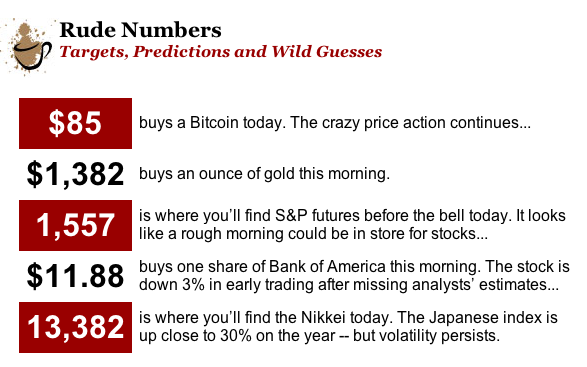Today a legend in the business told King World News that Switzerland may be preparing to purchase a stunning 1,000 tons of physical gold. Keith Barron, who consults with major gold companies around the world and is responsible for one of the largest gold discoveries in the last quarter century, spoke about this remarkable situation and what it means for investors. Below is what Barron had to say in part II of this exclusive interview.
Gold & Precious Metals
Greg Weldon – MoneyTalks Trial Offer
Posted by Michael Campbell
on Friday, 19 April 2013 7:00
 Greg offers global macro research, metals research, and a daily TrendTRAKR for US Equities that reveals trends in the S&P 500 stocks and US Sector ETFs using their proprietary Trend Momentum Indicators.
Greg offers global macro research, metals research, and a daily TrendTRAKR for US Equities that reveals trends in the S&P 500 stocks and US Sector ETFs using their proprietary Trend Momentum Indicators.
The flagship publication is Weldon’s Money Monitor LIVE which is his global macro publication. It is produced regularly in an ‘audio’ presentation with compelling market charts that includes top down macro and bottom up technical along with Greg’s personal commentary (printable pdf is available).
Weldon also offers Metals Research and TrendTRAKR for US Equities which is very powerful trading tool for those who trade US Equities. It is a daily publication that offer trend data for the S&P 500 stocks and US sector ETFs. You can see descriptons and samples of each product by clicking on them and watching the YouTube videos Greg has prepared.
As MoneyTalks listeners and members you are invited to trial ALL THREE research products, at no cost, for 30 days (10 days more that the regular free trial). Just select MICHAEL CAMPBELL from the list of referral choices when you sign up to get the extra days.

Embry – Physical Buying Intensifying On Lower Gold
Posted by Fascinating Authors via King World News
on Thursday, 18 April 2013 12:06
 In the aftermath of the brutal takedown in gold and silver, “April 17th” John Embry spoke with King World News about why he believes the smash was orchestrated and what investors should be doing right now. Below is what Embry, who is chief investment strategist at Sprott Asset Management, had to say in part II of his interview:
In the aftermath of the brutal takedown in gold and silver, “April 17th” John Embry spoke with King World News about why he believes the smash was orchestrated and what investors should be doing right now. Below is what Embry, who is chief investment strategist at Sprott Asset Management, had to say in part II of his interview:
Embry: “The last correction that was brutal in gold was explainable because that was the one in 2008 accompanying the global liquidity crisis that was wreaking havoc on the entire world. So at that time there were obvious reasons for the forced selling.
This time the smash and forced selling have just been totally manufactured. The intensity of this takedown and the size of the paper trades that were alluded by both Andrew Maguire and John Hathaway, in relation to the physical market, are just preposterous….
Continue reading the John Embry interview HERE
Switzerland To Buy A Stunning 1,000 Tons Of Physical Gold?
Barron: “What we discussed earlier, the fact that ABN AMRO was refusing to give customers their gold back, is one of the primary things that has triggered this massive run on physical gold and silver….
Continue reading the Keith Barron interview HERE
Rick Rule Weighs In On The Gold & Silver Takedown
“Professional capitulation is a wonderful sign. That isn’t to say that we are ready to turn now, or we are ready to turn next week, but the set of circumstances that we have been talking about, which is the beginning of the end of the dark period, is what we are in right now.”
….read it all HERE

GOLD: Now is the Time When We Juxtapose
Posted by Greg Guenthner via The Rude Awakening
on Wednesday, 17 April 2013 20:02
What Smart Minds Think on Gold
Adam Taggart
Despite plunging prices, the smart minds still see precious metals as the best option for preserving (and likely increasing) the purchasing power of one’s wealth.
John Hussman: markets are dangerously out of equilibrium; precious metals will provide security during the inevitable correction. John Mauldin: gold is essential insurance against central bank monetary recklessness. Mish Shedlock: renewed stress in the credit markets is inevitable; gold will be one of the smartest/safest places to park capital during this time. Charles Hugh Smith: cash and gold are prudent positions given market fundamentals and both will likely rise from here.
Richard Russell, an economic analysis legend, says today’s financial market conditions are unprecedented. Today’s elevated market prices are dangerously unsupported by fundamentals, and caused by manipulation and opportunistic self-interest by central planners, big banks, politicians and corporations. “What else but gold?” should investors hold at this point, he asks.
Mike Maloney is frustrated by efforts to suppress the gold and silver price, even though it’s allowing savvy investors to accumulate metal cheaply. But the false signals given by low prices keep the smaller investor, who could benefit most from protecting their wealth, from entering the market. And even though he remains confident precious metals prices will be much higher in the future, those prices will be the result of a destruction of the monetary system and a corruption of the free markets.
None of these smarter minds is a cheerleader. They arrived at their positions through empirical analysis. They are not pushing gold to make a buck or advance an ideological agenda. These are concerned men looking to find options that will help their followers prosper.
Weeks like this are just noise. In fact, they’re good opportunities to add to your positions at lower cost.
….read full article HERE
And now for a VERY FIRM OPINION – ED
DON’T BUY GOLD
Prepare for lower prices…
Dissecting an emotional market…
Plus: My overdue Bitcoin bragging rights!
Gold’s dropping. You want to buy.
But wait just a minute…
Is your desire to buy gold now based on reasonable analysis of market conditions? Or is it simply an emotional reaction to the selloff?
Let’s turn to one of your letters for some answers:
“Short-term I can understand your premise on gold,” writes a somewhat reasonable reader.
“Markets are doing well so people head in that direction. But for the long-term, I’m a buyer. I think there’s a lot of inflation coming. So I’ll slowly buy in expecting lower priced and will be excited when they fall. But later I’ll expect higher prices and will be excited as they rise… sort of.”
Sounds like you’re grasping at straws here.
I can’t make this any clearer: You shouldn’t even consider trying to buy gold right now.
After all, you are a long-term investor, correct? Give gold a chance to consolidate or move lower. When was the last time you saw any asset class permanently recovered from a violent drop the very next day? It just doesn’t work that way…
There will be snapback rallies and more downside. Expect to wait a long, long time before a suitable base forms.
Also, think about what you just wrote: Markets are doing well so people head in that direction…
Apply this line of thinking to gold. The gold market was booming. So naturally, people headed in its direction. Investors, traders, hedge funds and your crazy coworker bought gold. People wanted to own it because of its performance. Now they are leaving. And they won’t be rushing back to buy anytime soon.
Look, I know there’s a ton of shouting going on out there about where gold might end up.
Every blogger and financial journalist with 15 free minutes and a WordPress account is publishing their own takedown of gold after its big drop.
But where were these guys last month? Where were they when gold began telegraphing trouble in February after it broke below $1,650? If had to guess, I would say they simply weren’t paying attention. It’s so easy to pile on after the fact…
However, this is not your signal to jump into gold to prove them all wrong.
The loudest howls (by far) are coming from those defending gold. They pound the table about multinational conspiracies, computer trading, and the unwashed masses selling gold for all of the wrong reasons. They’ve even blamed the charts that they loved so much over the past 10 years!
I’ll pose the same question I asked the detractors:
Where were these arguments when gold was soaring higher every month? Why has the narrative suddenly changed?
Any way you twist it, powerful emotional forces are at work. Denial is in control right now. Acceptance is a long way off…
I repeat — don’t jump back into gold. It’s too soon.
If you are well versed in trading, you could try to play a snapback move in gold futures or miners.
If that’s your game, keep tight stops and expect the unexpected. This thing is just getting started…


“Hey Greg, you forgot the bragging rights for calling the Bitcoin rocket blastoff and harsh landing,” writes an astute reader.
You’re right. I forgot that one. But I’m gonna strain my shoulder if I continue to pat myself on the back at this rate…
Also, remember my note last week about the Goldman report? I said shorting gold would be a risky move. Talk about a missed opportunity. In that case, running with the devil would have worked out perfectly.
[Ed. Note: Send your feedback here: rude@agorafinancial.com” target=”_blank”>rude@agorafinancial.com — and follow me on Twitter: @GregGuenthner]

- U.S. Oil Royalties Party…All AREN’T Invited!
- A new alternative to the dollar, euro… or even gold?
- Expert Reveals “It’s Too Late to ‘Save’ America…”

In the opening years of the last decade, most mainstream investors sat on the sidelines while “tin hat” goldbugs rode the bull market from below $300 to just over $1,000 per ounce. But following the 2008 financial crisis, when gold held up better than stocks during the decline and made new record highs long before the Dow Jones fully recovered, Wall Street finally sat up and took notice. The new devotees helped to push gold to nearly $1,900 by September of 2011. For the next year and a half it held relatively steady, trading mostly between $1,500 and $1,800 as more mainstream investors caught the fever. But now it appears that the brief love affair is at an end. It was really only a flirtation as the two were never a good match in the first place. Gold’s new suitors never understood the fundamental case for gold and now they are turning their affection back to their true love: U.S. equities.
This is creating a brutal season for gold investors. The metal is in the midst of its largest pull back in nearly five years, and as the selling has gathered momentum powerful Wall Street voices as diverse as Goldman Sachs and George Soros have declared the end of its nearly fifteen year run of dominance.
The story line put out by most of these analysts is that gold shined as a safe haven during the Great Recession, but its allure has evaporated with the recent “improvements” in the global economy, particularly in the United States. Ironically, this ignores the fact that gold actually performed better in the years leading up to the 2008 financial crisis than it did during or following the crisis. That may be because the inflationary monetary policy that fueled the housing bubble also powered gold. Deflation fears led to gold’s 35% decline in 2008, but once the Fed reopened the monetary spigots gold rallied to new highs. But in 2008 gold fell in concert with nearly every other asset class. This time, it’s falling while other assets are rising. The negative spotlight makes the current decline potentially more meaningful.
Neither the new round of Keynesian expansion in Japan nor the recent fallout from the Cypriot solvency crisis produced gold rallies. Bears cite these failures as the signs that the bull is dead. The latest warning bell came late last week when the Bank of Cyprus announced that it would be selling its gold reserves in order to raise the cash to pay its debts. Concerns quickly spread that other heavily indebted Mediterranean countries with large gold reserves like Greece, Portugal, Italy and Spain would follow suit. The tidal wave of selling would be expected to be the coup de grace for gold’s glory years. While this neat narrative may be sufficient to convince the financial media that an historic shift is underway, wiser minds will see more nuance.
While the vast majority of economists see gold as the “barbarous relic” described by Keynes, the sentiment has not stopped many central bankers from holding huge quantities as currency reserves. It is a curious phenomenon that the countries with the most daunting debt problems have the highest percentage of gold in their foreign exchange reserves. Many of these countries were formerly prosperous, and at various points in their histories had gold-backed currencies that required large reserves. These legacy assets now account for the bulk of their reserve wealth.
The United Stated leads the pack with both the largest amount of gold in reserve (8,133 tons) and one of the highest percentages (76%). Other heavily indebted developed countries are not far behind: Italy has 2,450 tons and 72% of reserves, France has 2,435 tons and 71% reserves, Portugal has 382 tons and 90% reserves, and Greece has 112 tons and 82% reserves. Tiny Cyprus, whose travails are creating global ripples, has just 14 tons (58% of reserves).
In contrast, the quickly developing emerging market economies are conspicuous for very small gold reserves, particularly in comparison to their much larger reserves of foreign currencies. Many of these countries have generated large amounts of U.S. dollar reserves as a result of ongoing trade surpluses. While China has more than 1,000 tons of gold, the cache only represents 2% of their enormous foreign exchange coffers. Even gold loving India has just 10%. Neither Russia, Taiwan, Thailand, Singapore, Mexico, South Korea, Indonesia, Malaysia, Saudi Arabia, nor Brazil has more than 10% (with most having far less than 5%). Bankers and political leaders in all of these countries, particularly India and China, have lamented publicly about the very high percentage of U.S. dollars in their reserves, and have even spoken fondly about the reliability and importance of gold.
The heavy debtors in the Eurozone have few pleasant options to deal with their insolvency. As illustrated by Cyprus, the choices may come down to painful austerity or raiding supposedly sacred bank deposits. The sale of gold reserves may provide a much more palatable option for politicians. After all, do voters really care how much gold sits in national vaults? For now at least, international central bank gold agreements limit the amount of gold that they can sell in a given year. But as these sovereign debt crises deepen for countries like Italy and Portugal, many justly question how long these paper agreements will keep the selling pressure at bay.
While I believe that they may indeed succumb to the temptation, such moves may not be disruptive, or even negative for gold. Large divestitures by some countries may lead to corresponding accumulations cash rich, but gold poor, creditor nations like India, China, Russia, and Indonesia. Such transactions would likely take place through private, direct, and tightly communicated sales. As a result, they would be far less disruptive than would be the case were they to occur in relatively thinly traded public markets as many now fear.
Such a transfer in gold holdings would be the logical result of the drift of the global economy over the past half century. Despite its current disfavor, gold is real wealth. Governments and bankers know this. As the emerging economies gain wealth, and the developed countries dissipate wealth through welfare-state debt accumulation, it is inevitable that the gold follows. It’s not a question of if, but when.
While nations buying gold will pay for their purchases with dollars, the sellers will not re-invest the proceeds into Treasuries. Dollars raised through gold sales will be converted to local currency and used to repay debt. This will put downward pressure on both the U.S. dollar and Treasuries. In addition, emerging market central bankers will be more likely to hold onto gold for the long-term, thereby providing a bullish impact on the market. In essence, such a shift would flush out the weak hands who don’t have the resources to protect their wealth in favor of stronger hands that do.
Creditor nations that buy gold cheap from bankrupt nations forced to sell at distressed prices will see the value of their reserves swell, thereby gaining the independence and confidence they need to finally break their reliance on the U.S. dollar as their principal reserve asset. When the reign of “king dollar” finally comes to a belated end, let’s hope all the gold we allegedly have stored in Fort Knox is actually there. We’re going to need every ounce of it.
To order your copy of Peter Schiff’s latest book, The Real Crash: America’s Coming Bankruptcy – How to Save Yourself and Your Country, click here.
For in-depth analysis of this and other investment topics, subscribe to Peter Schiff’s Global Investor newsletter. CLICK HERE for your free subscription.

Gold and Silver Update 3:00PM DST Gold $1,350 Silver $23
Posted by Peter Grandich - Grandich.com
on Monday, 15 April 2013 21:05
After watching all the gains of the last 5 years get wiped out and lose more money on paper and in actual losses than I could have ever imagined to have had not that many years ago, I still am keeping an old Mark Twain saying that I failed to do in the first half of my career – “If you always tell the truth you don’t have to remember what you said”.
First let me start by saying eating this

taste better than eating this.

Having been on the right side for well over a decade and even sidestepping previous major corrections, yours truly didn’t see this plunge in gold and silver coming. To those that have (and while apologetic be advised its not to those who have been bearish all the way up as they’re little more than broken clock forecasters who like a clock are right just twice a day) correctly forecasted this sell-off, congratulations.
In a world where “what have you done for me lately” has become a way not just on Wall Street but in life itself, the only question is where do we go from here?
In the very near-term (like hours to a few days) I’ve no idea. One thing when markets plunge like this, they mimic earthquakes. Even if there aren’t any more quakes, plenty of aftershocks are possible. Knowing how the financial services industry and much of the financial media that follows it has a negative slant against gold no matter what; I fully expect a wave of bearish forecasts and chest pounding bears to be front and center until further notice.
The gut check one must do is to first remember a golden rule – the ultimate crime in investing is not being wrong but staying wrong. Has what led a decade-long run in gold faltered?
I’ve said for years that there have been four primary factors to the great bull run:
- Central Banks, once dominant sellers became neutral or net buyers (thereby removing the single largest negative that existed for years).
- Gold producers, who once literally cut their noses to spite their faces by selling production forward, have up until now made significant hedging a thing of the past.
- The world has been on a race to debase paper currencies, printing piles of new paper money while piling up debt to unsustainable levels and this has allowed gold to become an alternative to paper (funny) money.
- The creation of ETFs allowed an enormous amount of institutional money to become buyers that otherwise most likely would not have sought exposure to gold otherwise.
So let’s see if the crime is staying wrong:
- The Cyprus threat (that a former Goldman Sachs Managing Director and now President of the European Central Bank conveniently mentioned right after his former employee issue a major sell and short gold commentary) is the only potential central bank sale known at this time and its really small potatoes in the bigger picture. I fully expect a few months from now we will learn that certain Central Banks were in fact major buyers during this swoon.
- I haven’t notice or heard discussed any significant increase in hedging and believe any producer who does will not be looked on fondly by its shareholders.
- Guess what? The Japanese QE only made the race to debase, to print oodles of new paper money and add to the pile of already too much debt, more of a bullish factor.
- The ETF scenario is the only one that may have been impacted as its seeing large scale liquidation but will turn a negative only if that keeps up even when the paper market rallies.
The hardest part of the puzzle has been up until to now, the huge difference in the paper versus the physical market for gold and silver. Look, when we had the gas crisis in the 70s and afterwards, the used car market saw a flood of gas guzzlers sold onto the market. When the real estate market blew up, inventory of homes for sale went through the roof. Yet, despite the severe sell-off in the paper market of gold and silver, companies and people who buy and sell physical gold and silver continue to report extreme shortages of available physical gold and silver. If you asked yourself this, I can only shake my head as well.
Bottomline – It won’t be quick and pain and anguish will still be around but when it comes to gold, just know this.


-
I know Mike is a very solid investor and respect his opinions very much. So if he says pay attention to this or that - I will.
~ Dale G.
-
I've started managing my own investments so view Michael's site as a one-stop shop from which to get information and perspectives.
~ Dave E.
-
Michael offers easy reading, honest, common sense information that anyone can use in a practical manner.
~ der_al.
-
A sane voice in a scrambled investment world.
~ Ed R.
Inside Edge Pro Contributors

Greg Weldon

Josef Schachter

Tyler Bollhorn

Ryan Irvine

Paul Beattie

Martin Straith

Patrick Ceresna

Mark Leibovit

James Thorne

Victor Adair
